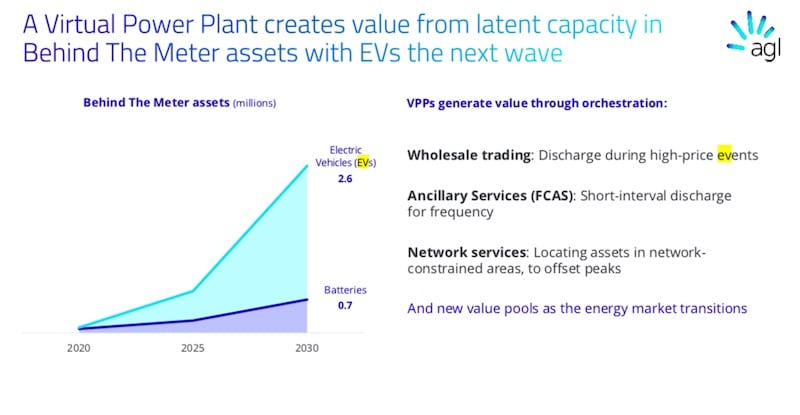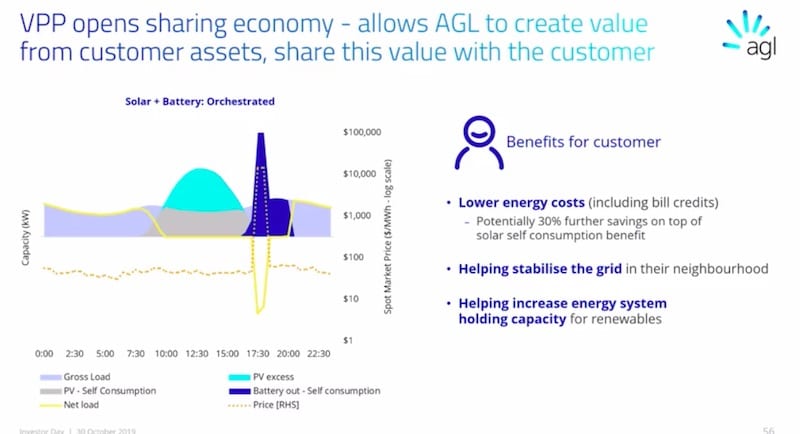Electric vehicles will drive 20-fold lift in battery storage capacity by 2030, says AGL
AGL
says it anticipates a 20-fold increase in behind the meter battery
storage capacity in Australia over the next 10 years, driven by the
influx of electric vehicles which it says will account for half of all
new car sales by 2030. And it intends to tailor its business
accordingly.
In a sure sign that AGL is recognising the shift from a business model based around centralised generation, AGL says its future business model will be based on the “shared” economy in electricity and transport, focused around customer choice of rooftop solar, household batteries and electric vehicles.
In its annual “investor day” presentation to analysts on Wednesday, which also included news of its contract to buy four large scale batteries in NSW, and its intention to seek other big battery opportunities in other parts of the grid, AGL predicted there would be 2.6 million EVs on the road in Australia by 2030.
This
would mean that EVs would account for around 50 per cent of new car
sales – just as outlined by Labor in its pre-election policy targets
that were mocked by the Coalition and conservative media.
Not only that, AGL expects the shift to autonomous driving and shared transport to also happen quickly. “Less than 1/3 of consumers will actually own cars,” says Dominique Van Den Berg , the head of distributed energy at AGL. “Electric vehicles will accelerate that transition.”
The company’s presentation noted the number of homes and businesses with battery storage would likely jump to 700,000 by 2030, but in some scenarios could match the current coverage of rooftop solar, or about one in four homes, or nearly two million.
B
However, this is expected to be dwarfed by the number of electric vehicles on the road, which could increase the battery storage capacity 20-fold by 2030, to a total of 40GWh, with most of that coming from EVs.
Some analysts, such as Bloomberg, have suggested that the battery resource from EVs could be ten times that number once the fleet becomes fully electric, and AEMO, like other international grid operators, is also starting to study how it can tap into that resource.
The trick for utilities like AGL will be to understand when, where and how they will be charged and able to provide energy back into the grid, and how to harness those assets into their business models and consumer offerings. AGL’s focus in on “orchestration”. But it’s yet to be seen how that can be done.
AGL’s efforts are being driven by changes in technologies and also emerging competition from new retailers eyeing opportunities in distributed energy. The UK-based and Mitsubishi backed Ovo Energy this week won a retail licence to operate in Australia, and is expected to bring its focus on combining rooftop solar, battery and electric vehicle charging options for consumers.
Oil giant Shell is also looking to enter Australia’s electricity market, and has made an agreed bid for ERM Power, as it prepares for what it sees as the inevitable “electrification” of transport and manufacturing.

In a sure sign that AGL is recognising the shift from a business model based around centralised generation, AGL says its future business model will be based on the “shared” economy in electricity and transport, focused around customer choice of rooftop solar, household batteries and electric vehicles.
In its annual “investor day” presentation to analysts on Wednesday, which also included news of its contract to buy four large scale batteries in NSW, and its intention to seek other big battery opportunities in other parts of the grid, AGL predicted there would be 2.6 million EVs on the road in Australia by 2030.
Not only that, AGL expects the shift to autonomous driving and shared transport to also happen quickly. “Less than 1/3 of consumers will actually own cars,” says Dominique Van Den Berg , the head of distributed energy at AGL. “Electric vehicles will accelerate that transition.”
The company’s presentation noted the number of homes and businesses with battery storage would likely jump to 700,000 by 2030, but in some scenarios could match the current coverage of rooftop solar, or about one in four homes, or nearly two million.
B

However, this is expected to be dwarfed by the number of electric vehicles on the road, which could increase the battery storage capacity 20-fold by 2030, to a total of 40GWh, with most of that coming from EVs.
Some analysts, such as Bloomberg, have suggested that the battery resource from EVs could be ten times that number once the fleet becomes fully electric, and AEMO, like other international grid operators, is also starting to study how it can tap into that resource.
The trick for utilities like AGL will be to understand when, where and how they will be charged and able to provide energy back into the grid, and how to harness those assets into their business models and consumer offerings. AGL’s focus in on “orchestration”. But it’s yet to be seen how that can be done.
AGL’s efforts are being driven by changes in technologies and also emerging competition from new retailers eyeing opportunities in distributed energy. The UK-based and Mitsubishi backed Ovo Energy this week won a retail licence to operate in Australia, and is expected to bring its focus on combining rooftop solar, battery and electric vehicle charging options for consumers.
Oil giant Shell is also looking to enter Australia’s electricity market, and has made an agreed bid for ERM Power, as it prepares for what it sees as the inevitable “electrification” of transport and manufacturing.

AGL’s
Van Den Berg says the shift to EVs is inevitable, given the expected
arrivals of more models, increased range, and when prices fall to the
same ticket price of internal combustion engine cars, than the uptake
will soar.
“Half of all new cars sales
will be electric vehicles,” Van Den Berg said. “The principle of
orchestrating a home battery is exactly the same as for a mobile
battery. But when, where and how we charge is more complex.”
“We
are looking at more than 7000MW (of storage) in system. That’s the
equivalent of 28 open cycle gas turbines,” she said. “In many respects
we have got to manage these assets in the same way as we manage gas
assets.”
To
illustrate the point about the so-called “shared economy”, and how it
applies to the energy industry, Van Den Berg gave this example of how
that “orchestration” could work, how it allowing the utility to tap into
the household battery resource, and how it could allow the household to
tap into high priced events.
“This is the
approach of the shared economy business, the value of these assets is
worth so much more with (connection and orchestration) than without,”
she said. The graph above shows the benefits of using the battery in
high prices events that could deliver extra revenue (maybe close to $300
a year) that would not be available otherwise.
In
fact, AGL wants to be able to manage these assets in much the same way
as it does larger assets on the wholesale market. One of the big targets
will be the “solar duck curve” which is lowering demand and prices in
the middle of the day.
Price variations are
increasing and the company intends to use this price signal, and the
need for dispatchable and flexible capacity as more coal plants exit the
market, to invest in batteries and pumped hydro power station.
Giles Parkinson is founder and editor of Renew Economy, and is also the founder of One Step Off The Grid and founder/editor of The Driven. Giles has been a journalist for 35 years and is a former business and deputy editor of the Australian Financial Review.
-
Massive 1.3MW rooftop solar system completed at Cairns DFOby Sophie Vorrath on 31 October 2019 at 12:28 PM
-
Home batteries hit the floor to adapt to Australia’s strict new standardsby Sophie Vorrath on 30 October 2019 at 12:55 PM
-
All eyes on Australia battery market, as home storage becomes a “need”by Sophie Vorrath on 29 October 2019 at 2:32 PM
-
Tesla full self driving price will rise in Australia once Smart Summon is availableby Bridie Schmidt on 31 October 2019 at 1:34 PM
-
Lightyear One solar car sets record for world’s most aerodynamic carby Bridie Schmidt on 30 October 2019 at 1:40 PM
-
Hyundai Kona becomes first EV to undergo crash tests in Australia, earns five starsby Bridie Schmidt on 30 October 2019 at 12:15 PM





:quality(85)/https%3A%2F%2Freneweconomy.com.au%2Fwp-content%2Fuploads%2F2019%2F10%2FIMG20191006130955-copy-1600x800-300x150.jpg)
:quality(85)/https%3A%2F%2Freneweconomy.com.au%2Fwp-content%2Fuploads%2F2019%2F08%2Fsunraysia-solar-farm-300x171.jpg)
:quality(85)/https%3A%2F%2Freneweconomy.com.au%2Fwp-content%2Fuploads%2F2016%2F09%2FiStock_91006587_SMALL-300x169.jpg)
:quality(85)/https%3A%2F%2Freneweconomy.com.au%2Fwp-content%2Fuploads%2F2016%2F09%2Fzen-richard-turner-300x169.jpg)
:quality(85)/https%3A%2F%2Freneweconomy.com.au%2Fwp-content%2Fuploads%2F2019%2F10%2Fhydro-tas-pumped-hydro-battery-nation-wide-view-of-strathgordon-dam-in-tasmania-optimised-300x169.jpg)
:quality(85)/https%3A%2F%2Freneweconomy.com.au%2Fwp-content%2Fuploads%2F2019%2F08%2FCarnegieCETO19-300x188.jpg)
 powered by plista
powered by plista

No comments:
Post a Comment